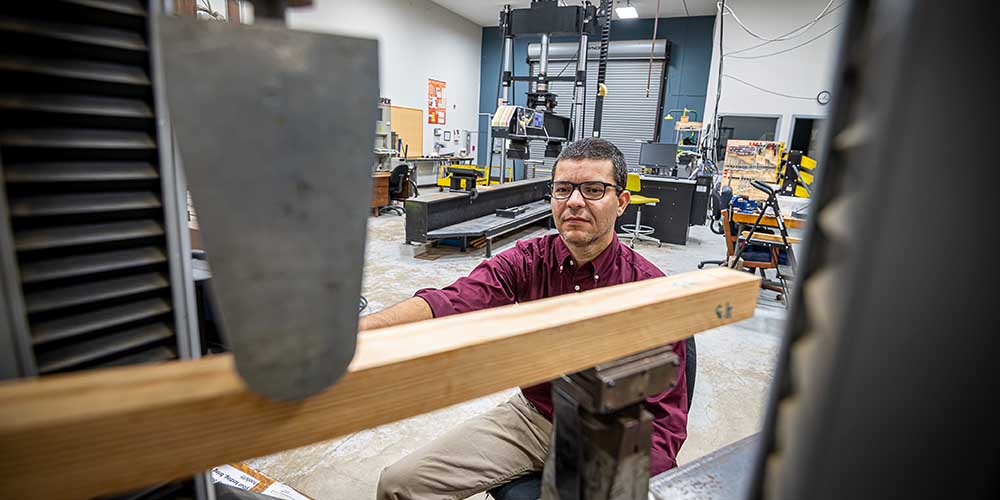Bioproducts Testing and Evaluation Stories

Bend, Break, Evaluate
Scientists in the Forest and Wildlife Research Center completed a five-year study to help increase the value of forests. Several faculty members, including Drs. Rubin Shmulsky and Dan Seale, and dozens of graduate students conducted a two-part study that involved several methods of nondestructive testing to evaluate the accuracy and reliability of those methods, which are widely used for grading and testing structural lumber. The team was specifically interested in the linear relationship of the modulus of elasticity (MOE) and modulus of rupture (MOR) and how MOE can predict MOR. Once they compared the results, to find and increasing board performance and economic value, they found that there are achievable ways to better evaluate the economic value of lumber: testing the tension of the wood.
They evaluated how still and strong single sticks of wood were, which helped further prove that the stronger the wood, the higher profit and longevity of the land in the forests can be.
2018

FWRC Researchers Study 50 Years of Southern Yellow Pine Properties
Southern yellow pine is one of the most readily available softwoods in the U.S. and, due to its availability, performance, and affordability, it is used broadly in construction. Scientists in the Forest and Wildlife Research Center have conducted research to assess the flexural-tendency to bend or deform under load-properties of southern yellow pine from three samples that span over 50 years. Dr. Frederico Franca, assistant professor in sustainable bioproducts, specializes in non-destructive testing of wood products. He is part of a team that recently sampled and conducted tests on southern yellow pine and pulled data from specimens collected from the early to mid-1960s from the USDA Forest Service Forest Products Laboratory in Madison, Wisconsin. The team evaluated southern yellow pine's density, bending strength and stiffness, as well as compression parallel and perpendicular to the grain.
After comparing the clear wood flexural properties of southern yellow pine taken across approximately five decades, the researchers found an increase in some wood properties and stability, which helped confirm that southern yellow pine remains reliable, strong, and safe for structural uses.
This research was supported by the USDA Agricultural Research Service, under agreement no. 58-0204-6-001, and the Forest and Wildlife Research Center.
2022

Knots Untangled
Researchers in MSU’s Forest and Wildlife Research Center hope to untangle how knots—remnants of where branches grew while the tree was alive—affect the stiffness and strength of this important commodity. The team set out to investigate the role multiple knots in proximity play on affecting lumber stiffness and strength to increase the value of southern pine. In a series of studies spanning several years, Drs. Rubin Shmulsky, professor and head; Dan Seale, professor; and Jason Street, associate professor, led a team of graduate students as they analyzed southern pine boards produced at a local Mississippi sawmill to determine if small clusters of knots impacted lumber stiffness and strength. The research’s goal is to find a more accurate way of measuring the mechanical properties of lumber so that a more particular strength rating can be associated with each piece produced.
This research was funded by the Forest and Wildlife Research Center and the USDA Forest Service Forest Products Laboratory in Madison, Wisconsin.